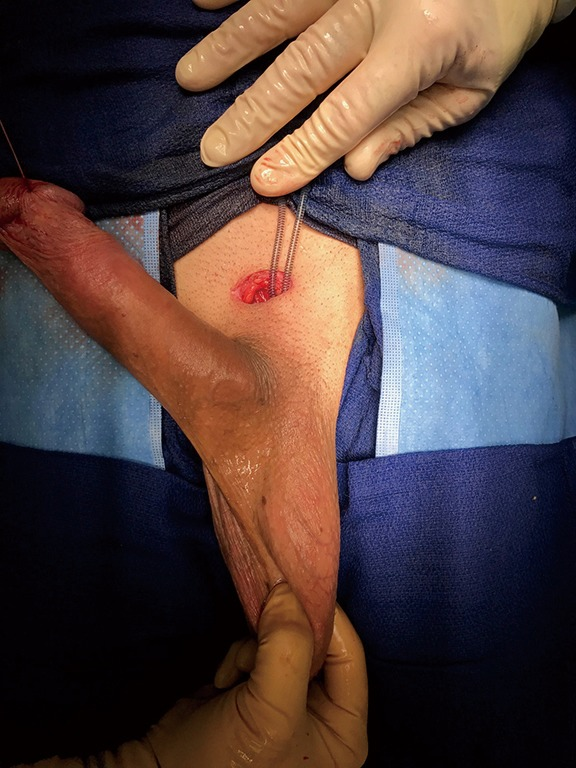Minimally invasive infrapubic approach for inflatable penile prosthesis: perioperative and medium-term results
Erectile dysfunction (ED) refractory to medical treatments often leads to consideration of surgical solutions. Inflatable penile prosthesis (IPP) implantation remains the definitive option for many. Among surgical approaches, the infrapubic approach (and its minimally invasive variant, MIIA) has gained attention for potentially improving operative time, recovery, and satisfaction, while maintaining acceptable safety profiles. This article reviews a key research study that followed patients for at least five years post-implantation using the infrapubic minimally invasive approach, with validated measures of outcomes.
Study Design & Methods
- Population: 67 patients received IPP via the Minimally Invasive Infrapubic Approach (MIIA).
- Follow-up Duration: Median follow-up of 71 months (IQR 63-80 months).
- Assessments: Complications (minor and major), device survival over time (Kaplan-Meier analysis), functional outcomes & patient satisfaction using QoLSPP (Quality of Life and Sexuality with Penile Prosthesis) questionnaire.

Results
Complication Rates
- Overall, 15/67 patients (22%) experienced some complication.
Minor complications (Clavien ≤2):
• Change in penile sensitivity: 1 (1.5%)
• Orgasmic dysfunction: 1 (1.5%)
• Pain: 5 (7%)
• Urinary tract infection: 2 (3%)
• Chronic discomfort: 1 (1.5%) Major complications (Clavien ≥3):
• Mechanical failure: 3 (4.5%)
• IPP infection: 1 (1.5%)
• Cylinder protrusion: 1 (1.5%)
Device Survival
High survival rates were reported:
• At 3 years: ~94% (95% CI: 91.4-96.6)
• At 5 years: ~92.5% (95% CI: 89.7-95.3)
• At 7 years: ~92.5% (same interval)
Functional Outcomes & Patient Satisfaction
- Out of 61 patients using the device at follow-up (91%), QoLSPP questionnaire scores were favorable in multiple domains:
- Functional, Personal, Relational, Social dimensions all showed high satisfaction.
- Return to device usage and satisfaction remained strong over the mid-term.
Discussion & Interpretation
- The MIIA demonstrates strong safety: low rates of major complications, acceptable minor complications.
- Device durability is high – survival of IPP remains over 90% at 5-7 years.
- Patient and partner satisfaction is also high across multiple life domains (sexual function, self-esteem, relationships).
- Compared with more invasive approaches, MIIA may allow for faster recovery, less operative time (though direct comparison beyond this study is limited), possibly fewer hospital or wound-related issues.
Limitations
- Single-center data.
- Sample size, though fairly large for this kind of long term IPP study, still limits generalization.
- Some outcomes are self-reported (which may carry bias).
- Follow-up intervals may vary, some patients lost to follow‐up.
Conclusion
The minimally invasive infrapubic approach for inflatable penile prosthesis implantation shows excellent mid-term outcomes. It is safe, durable, and yields high patient satisfaction over at least 5 years. For patients with erectile dysfunction considering IPP, the MIIA is a very viable approach, particularly in centers with experience in penile prosthetic surgery.
Frequently Asked Questions (FAQ)
Q1. What is the minimally invasive infrapubic approach (MIIA)?
A1. It is a technique of implanting an inflatable penile prosthesis via an incision above the pubic area (infrapubic region), using less tissue dissection, smaller incisions, and modifications to traditional infrapubic methods to reduce invasiveness and improve recovery.
Q2. How long does device survival last with MIIA?
A2. According to the study, device survival was about 94% at 3 years, and ~92.5% at 5 and 7 years.
Q3. What are the risks / complications?
A3. Risks included minor issues such as pain, discomfort, change in sensitivity, urinary tract infection, and occasionally more serious ones such as mechanical failure, infection of the implant, or cylinder protrusion. Major complications were rare.
Q4. How satisfied are patients and partners after MIIA?
A4. Satisfaction scores were high in multiple domains: functional, personal, relational, and social. Most patients continued to use the device at follow-up.
Q5. Is MIIA better than other approaches like penoscrotal?
A5. In some comparative studies, MIIA showed shorter operative time and earlier return to sexual activity compared to penoscrotal approach. Satisfaction and complication rates were similar in many respects between approaches.
Q6. Who is a good candidate for MIIA?
A6. Men with erectile dysfunction for whom other treatments have failed, who have anatomy suitable for infrapubic approach, and in centers with surgeon experience. Comorbidities should be assessed, but the study suggests BMI or moderate health issues were not huge deterrents to good outcomes in many cases.